Mechanical stretch decreases migration of alveolar epithelial cells through mechanisms involving Rac1 and Tiam1
- PMID: 18805958
- PMCID: PMC2584892
- DOI: 10.1152/ajplung.90218.2008
Mechanical stretch decreases migration of alveolar epithelial cells through mechanisms involving Rac1 and Tiam1
Abstract
Mechanical ventilation can overdistend the lungs or generate shear forces in them during repetitive opening/closing, contributing to lung injury and inflammation in patients with acute respiratory distress syndrome (ARDS). Repair of the injured lung epithelium is important for restoring normal barrier and lung function. In the current study, we investigated the effects of cyclic mechanical strain (CS), constant distention strain (CD), and simulated positive end-expiratory pressure (PEEP) on activation of Rac1 and wound closure of rat primary alveolar type 2 (AT2) cells. Cyclic stretch inhibited the migration of wounded AT2 cells in a dose-dependent manner with no inhibition occurring with 5% CS, but significant inhibition with 10% and 15% CS. PEEP conditions were investigated by stretching AT2 cells to 15% maximum strain (at a frequency of 10 cycles/min) with relaxation to 10% strain. AT2 cells were also exposed to 20% CD. All three types of mechanical strain inhibited wound closure of AT2 cells compared with static controls. Since lamellipodial extensions in migrating cells at the wound edge were significantly smaller in stretched cells, we measured Rac1 activity and found it to be decreased in stretched cells. We also demonstrate that Tiam1, a Rac1-specific guanine nucleotide exchange factor, was expressed mainly in the cytosol of AT2 cells exposed to mechanical strain compared with membrane localization in static cells. Downregulation of Tiam1 with 100 microM NSC-23766 inhibited activation of Rac1 and migration of AT2 cells, suggesting its involvement in repair mechanisms of AT2 cells subjected to mechanical strain.
Figures
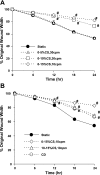
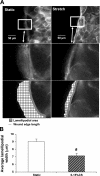
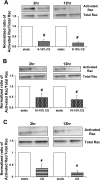
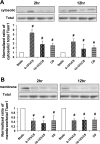
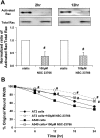
Similar articles
-
16-kDa prolactin inhibits endothelial cell migration by down-regulating the Ras-Tiam1-Rac1-Pak1 signaling pathway.Cancer Res. 2007 Nov 15;67(22):11045-53. doi: 10.1158/0008-5472.CAN-07-0986. Cancer Res. 2007. PMID: 18006851
-
Cyclic mechanical stretch decreases cell migration by inhibiting phosphatidylinositol 3-kinase- and focal adhesion kinase-mediated JNK1 activation.J Biol Chem. 2010 Feb 12;285(7):4511-9. doi: 10.1074/jbc.M109.084335. Epub 2009 Dec 14. J Biol Chem. 2010. PMID: 20018857 Free PMC article.
-
Roles of STEF/Tiam1, guanine nucleotide exchange factors for Rac1, in regulation of growth cone morphology.Mol Cell Neurosci. 2003 Sep;24(1):69-81. doi: 10.1016/s1044-7431(03)00122-2. Mol Cell Neurosci. 2003. PMID: 14550769
-
The guanine nucleotide exchange factor Tiam1: a Janus-faced molecule in cellular signaling.Cell Signal. 2014 Mar;26(3):483-91. doi: 10.1016/j.cellsig.2013.11.034. Epub 2013 Dec 2. Cell Signal. 2014. PMID: 24308970 Review.
-
[Research progress on the proliferation and differentiation of type Ⅱ alveolar epithelial cells].Zhonghua Jie He He Hu Xi Za Zhi. 2025 Mar 12;48(3):282-286. doi: 10.3760/cma.j.cn112147-20241009-00586. Zhonghua Jie He He Hu Xi Za Zhi. 2025. PMID: 40050081 Review. Chinese.
Cited by
-
Mechanical boundary conditions bias fibroblast invasion in a collagen-fibrin wound model.Biophys J. 2014 Feb 18;106(4):932-43. doi: 10.1016/j.bpj.2013.12.002. Biophys J. 2014. PMID: 24559996 Free PMC article.
-
Myosin IIB deficiency in embryonic fibroblasts affects regulators and core members of the par polarity complex.Histochem Cell Biol. 2011 Sep;136(3):245-66. doi: 10.1007/s00418-011-0840-0. Epub 2011 Jul 23. Histochem Cell Biol. 2011. PMID: 21785947
-
A heteromeric molecular complex regulates the migration of lung alveolar epithelial cells during wound healing.Sci Rep. 2017 May 19;7(1):2155. doi: 10.1038/s41598-017-02204-2. Sci Rep. 2017. PMID: 28526890 Free PMC article.
-
Protein kinase R-like endoplasmatic reticulum kinase is a mediator of stretch in ventilator-induced lung injury.Respir Res. 2018 Aug 22;19(1):157. doi: 10.1186/s12931-018-0856-2. Respir Res. 2018. PMID: 30134920 Free PMC article.
-
Altered expression of TIAM1 in endotoxin-challenged airway epithelial cells and rodent septic models.J Thorac Dis. 2018 Jun;10(6):3187-3195. doi: 10.21037/jtd.2018.05.192. J Thorac Dis. 2018. PMID: 30069314 Free PMC article.
References
-
- The Acute Respiratory Distress Syndrome Network. Ventilation with lower tidal volumes as compared with traditional tidal volumes for acute lung injury and the acute respiratory distress syndrome. N Engl J Med 342: 1301–1308, 2000. - PubMed
-
- Atabai K, Ishigaki M, Geiser T, Ueki I, Matthay MA, Ware LB. Keratinocyte growth factor can enhance alveolar epithelial repair by nonmitogenic mechanisms. Am J Physiol Lung Cell Mol Physiol 283: L163–L169, 2002. - PubMed
-
- Cavanaugh KJ, Margulies SS. Measurement of stretch-induced loss of alveolar epithelial barrier integrity with a novel in vitro method. Am J Physiol Cell Physiol 283: C1801–C1808, 2002. - PubMed
-
- Cavanaugh KJ, Oswari J, Margulies SS. Role of stretch on tight junction structure in alveolar epithelial cells. Am J Respir Cell Mol Biol 25: 584–591, 2001. - PubMed
-
- Cerione RA, Zheng Y. The Dbl family of oncogenes. Curr Opin Cell Biol 8: 216–222, 1996. - PubMed
Publication types
MeSH terms
Substances
Grants and funding
LinkOut - more resources
Full Text Sources
Research Materials

